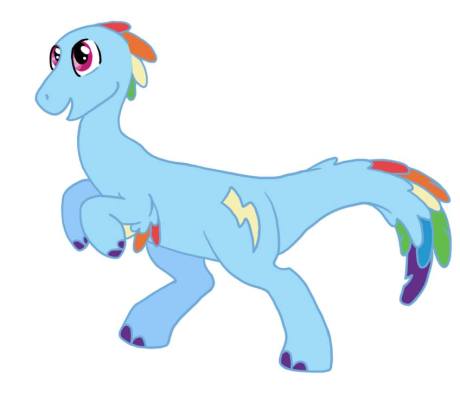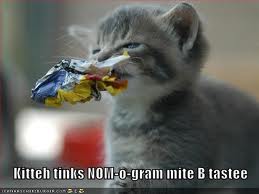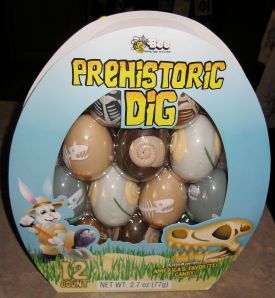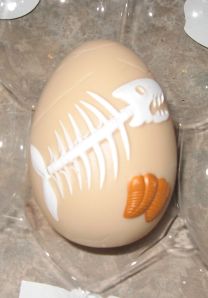Petite Prehistorics July 12, 2013
Posted by mareserinitatis in geology, older son, younger son.Tags: art, bronies, dinosaurs, geology, my little pony
4 comments
The interwebs may be familiar with Bronies…that is, boys who like My Little Pony or, as they prefer to call it, MLP. The older son became interested in them a couple years ago (apparently he writes Pony fanfic now), and the younger son is, of course, emulating his older brother. For his most recent birthday, the younger son received 3 stuffed Ponies, which absolutely thrilled him. He often takes them to daycare.
(I’d like to pause for a moment and say how I think it’s completely awesome that it’s okay for boys to like MLP given it would have been quite humiliating when I was a kid.)
The other morning, the younger son ran to grab a pony before daycare. (Pinky Pie? I have a hard time following.) He was also wearing one of his favorite shirts, which features a t-rex and says, “Kickin’ it, old school.” I took a picture of him posing with the pony and posted it on FB saying how I love that he likes both ponies and dinosaurs. My friend @karifur commented on the picture saying there should be My Little Dinos, at which point another very talented artist friend, Becky Barnes (who works for the state Geological Survey and creates the Fossils in ND newsletter) posted a pic of such a creation.
Sadly, because it would violate copyright, she can’t sell anything with these images, but she did say I could share them so that people can use them. Maybe you can make a t-shirt for a little girl who might get into dinosaurs if they were more pastel? I just ask, however, that if you use these images on the web, you give credit to Becky.
(Also, Becky made a dino coloring book, so maybe that would be a good gift, as well!) You can buy the book here.
Fields of irony July 1, 2013
Posted by mareserinitatis in career, engineering, geology, geophysics, grad school, research, work.Tags: career, electrical engineering, geology, geophysics, outdoors
add a comment
When I started thinking about what I wanted to do for grad school, I thought geophysics was a good option because I enjoy getting outside. I figured that if I were doing something related to geology, that opportunity would present itself much more often than in electrical engineering. I suppose this idea came because I was used to spending most of my time in a 10’x20′ windowless room…or a much bigger windowless lab. Either way, cabin fever sets in quickly when one is deprived of fresh air and sunshine most of the day.
Unfortunately, I discovered I wasn’t as crazy about ‘outdoor’ geology but fell in love with computationally intensive topics. I love getting outside and collecting rocks, but I view it more now as a hobby than as a career path.
Recently, however, I’ve been working with some people in another department on a project. This new project will probably require me to spend some time outside doing field work. It’s rather ironic that I may end up getting my outside time because of a project I’m doing in electrical engineering.
I guess it all works out in the end. Now if I could find a way to teach programming outdoors…
Repost: The varied and graphically-intensive world of nomograms March 3, 2013
Posted by mareserinitatis in electromagnetics, engineering, geology, geophysics, grad school.Tags: electrical engineering, geology, geophysics, magnetic fields, nomograms, smith chart
add a comment
I spent a good chunk of time yesterday dealing with Smith charts, and I remembered in the recesses of my brain that I had once posted something about them in the old blog. Sadly, it wasn’t as technically intensive as it could have been, but I still decided it was fun enough for a repost. If you would like to read something with a bit more technical content, you can check out Fluxor’s post on Smith charts at EngineerBlogs.
A nomogram is an incredibly useful tool. It is a visual “solution” to an equation. Usually it is some sort of chart or plot that allows you to figure out “what you’ve got” and you can move from there to “what you need”.
Anyone who works on the analog side of electrical engineering often gets to play with Smith charts, which were of course invented by Baker*. They’re rather confusing looking things:

The usefulness in Smith charts is that they can allow you to determine things like how much more transmission line you need to get an impedance match in your device. Rather than trying to solve an equation using complex values, you can just move along the curve in a Smith chart. (Disclaimer: While I learned how to use Smith charts in my microwave engineering course, I unfortunately would need to spend some time with my buddy Pozar to remember how to do it now.) I’m also aided in my negligence by the fact that there are a lot of nifty software programs that will compute the necessary values, reducing the necessity of using a Smith chart. (Thank goodness for computers. If it weren’t for computers, I’d probably have to learn how to use a slide rule, too.)
What brought this up is that I was introduced to a nomogram used by scientists in the field of paleomagnetism. The nomograms in this case showed relationships in demagnetization of magnetic minerals. For instance, if you have a mineral that has been exposed to a temperature of 400°C for 1000 seconds in the lab, you can follow the line on the nomogram and discover that the same amount of demagnetization could be caused by sitting in a temperature of 350°C for 100 million years.
So why do I spend time mentioning this on my LJ? Could it be because knowing that there are graphical methods to approximate solutions to problems is good to know? It is good to know, but it’s not why I bring it up. The reason I felt the need to post about it is because I had an entirely different picture of nomograms when I was sitting in class:
—–
*Just kidding. It was developed by Phillip H. Smith.
The best students December 7, 2011
Posted by mareserinitatis in education, geology, math, teaching, younger son.Tags: animals, cub scouts, geology, math, younger son
add a comment
At teacher conferences a few weeks ago, my son’s teacher mentioned that she was going to be taking a short period during the day to break kids into two groups. One group needed some help with some of the more basic concepts in math, while the others seemed fairly advanced.
I got very excited, and I asked if I could come in and do some fun math stuff with the advanced group. She said she’d appreciate it because then she could focus on the other kids who needed more help with things.
Yesterday was my first shot at this. It’s only about 20 minutes of seat time once a week (along with about an hour of prep, considering I have to bring in materials). I worked with a group of six, and it was fun.
That’s the one thing about teaching college versus elementary school kids: college kids never get excited the same way little kids do. Of course, maybe it’s because you have to use a fundamentally different approach – more hands on – with little kids. On the other hand, I think you lose something with maturity. I have worked with a couple different cub scout groups, and they often have requirements to learn some geology for various badges. There is something amazing that happens when you put a group of 6-10 year old boys in front of rocks and other things they can touch. They’re fascinated with everything and seem to hang on your every word (when they’re paying attention). When you do the same to college kids, they just kind of shrug and proceed forth, maybe discussing the rocks with neighbors.
For these kids, I’m using a Mathworks book on how to be a zoo vet, and I decided to let each kid have their own animal as we work through the problems. Yesterday, we talked about building crates because we’re shipping our animals from one zoo to another. The kids were SO excited that they got their own animal. I tried to bring a variety: there were poison arrow frogs, king cobras, and piranhas for the boys and pandas and koalas and dolphins for the girls. I was pretty close: the two girls chose dolphins and koalas, and the boys mostly went for the dangerous animals. (One chose a polar bear, which is on the fringe between dangerous and cute and cuddly, IMO.)
Either way, they were really getting into building their crates. They were talking about the differences in sizes between all the animals, and it’s amazing all the movement and excitement and gestures that go into discussions among 7-8 year olds.
After the twenty minutes was up, I was exhausted. My comment about how college students never seem to get excited is exactly why I prefer to teach them: I can’t handle the energy level of really young kids all day long. I have to admit that I admire elementary school teachers for doing this. However, despite being exhausted, I was really tickled with their excitement and the fun we had. I’m looking forward to next week.
“Why is this the hardest class?” November 17, 2011
Posted by mareserinitatis in engineering, teaching.Tags: engineering, geology, hardest class, teaching
2 comments
I’d like to know why I keep getting this question: “Why is your class the hardest?” I got it again today.
Okay…so I’m teaching a freshman skills class to engineering majors. In fact, the department specifically asked to have it’s own sections. If my students are thinking my class is hard, I have to wonder what’s going to happen when they really hit the hard ones.
I got this when I was teaching geology labs, though. My evals came back frequently with comments about how I graded much harder than I needed to, I expected too much for an introductory science class, etc.
The coordinator for the course actually went through and analyzed how each of us graded. It turned out that I had the most lenient lab grades and graded more harshly on the exams. (Honestly, if you read and understood the labs, all you had to do was regurgitate your answers for the lab.) It ended up that my grading resulted in the same average as the other TAs.
I’m trying to find out if I just look mean and intimidating because I don’t get it. I know I demand a reasonable amount of work, and I try to help the students as much as possible so they don’t get frustrated.
But apparently my classes are hard.
The Easter Bunny is a closet geologist April 24, 2011
Posted by mareserinitatis in geology, religion.Tags: easter, easter eggs, geology, trilobites
2 comments
I was shopping for Easter supplies (i.e. materials to color eggs) when I came across this gem:
Yes, folks, it is possible to enjoy science and religion at the same time. For some lucky children (like my own), they will be getting their candy-filled eggs in fossil replicas. If you’d like a closer look, here are the ‘fossils':
As you can see, we have some sort of mollusk shell along with some sort of green contaminant. (Apparently the Easter Bunny isn’t the best at keeping samples isolated.) There is also the skeleton of a young reptilian creature…maybe a dinosaur of some kind. The the best is the bony fish skeleton along with some green or brown things. Hmm.
The brown things look like they could be some sort of trilobite. Given I can’t figure out which trilobite order it belongs to, I will assume it’s an extremely primitive variety that showed up in the very early Cambrian. Definitely not Burgess Shale material.
It’s also difficult to tell what types of rocks these fossils formed in as they have an amazing lack of identifying texture or chemical reactivity. I guess I will have to leave the mysteries in the hands of more experienced paleontologists.
Despite all these questions, I quite approve of the eggs (since I bought a pack).
For those who celebrate have a Happy Easter!
Geologist’s nightmare July 26, 2010
Posted by mareserinitatis in Uncategorized.Tags: education, geology, teaching
add a comment
Lenore Skenazy (the mom who let her 9-year-old take the subway home alone) wrote a column about Consumer Product Safety Commission, which I thought was spot-on.
However, she began the column by talking about how a school opted not to buy rock samples because they thought the students would be better off looking at posters of rocks.
First, this makes me crazy. It’s bad enough that kids are taught geology by sitting in a classroom. Really. Geology is one of those things that I think you don’t get until you’ve been outside and have seen how it all fits together.
But now they’re not only sticking kids inside to learn about the outside, they’re replacing actual samples with pictures.
I’m sorry, but you can’t get a sense of many mineral characteristics unless you’re looking at samples. In fact, my experience is that you ought to have a few samples because some of them are lousy, and some of them are really good. In nature (that outside place where the kids aren’t allowed to go), you see both…really good samples and really lousy ones. In reality, the samples you see are usually somewhere in the middle.
Anyway, I’m appalled. When I’ve taught geology labs, we give the kids samples of galena (lead ore) to look at. The students have often asked me, “Isn’t that dangerous?” I tell them that they’re old enough to know not to lick their fingers and that they should probably wash their hands after lab so they don’t get it onto some food, where it may be accidentally ingested.
I haven’t had a single student suffer from lead poisoning.







 I also blog at Engineer Blogs, home away from home to some of the best engineering blogs.
I also blog at Engineer Blogs, home away from home to some of the best engineering blogs.